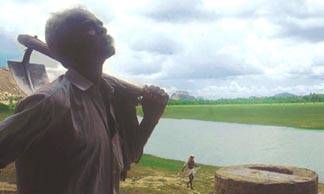| If you met Ganesan on the street, you will never
know that his work requires the skills of a top-of-the-drawer business executive. He
manages the water supply of Madaivini Patti, a hamlet on the outskirts of Village Vairavan
Patti in district Madurai, Tamil Nadu. He is a neerkatti (the irrigator in Tamil). The
chief ministers of Tamil Nadu and Karnataka will do well to use his water management
skills to settle the Cauvery riverwater dispute. There has never been a major dispute
among the farmers of his village regarding water.
Madaivini Patti consists of some 35 families. Poverty, though not abject, is clearly
visible. There is only one child who has completed higher secondary schooling. In the
off-season, the entire village works as casual labour in neighbouring areas.
Agriculture is limited to subsistence. There is hardly any surplus. Paddy is the main
crop and water is essential. The only source is the run-off from the monsoon. This travels
down the invisible slope of the Eastern Ghats, and collects in the age-old kanmoy,
as tanks are known here. Effective water management is crucial to social harmony. Ganesan
provides it.
He comes from the pallar caste, which is listed as a scheduled caste in the
state. But there are no special benefits from the government for Ganesan. He lives on what
he earns. Which includes the respect of the entire village. His caste status never clouds
the recognition and appreciation of his skills. Pallars have traditionally managed
the water supply in this area.
At all community functions, the village priests have to accompany Ganesan to the market
to make purchases, a symbol of his special status. He is the authoritative mediator, the
honest broker, the village elder. In not just the water disputes but even the social
disagreements within the village.
Says S Subramaniam, executive committee member of the village’s Tank Farmer’s
Association: "The neerkatti tradition is of great benefit. Faith in the neerkatti
is crucial to the smooth functioning of agriculture. Otherwise everyone will fight."
Ganesan knows the topography of the village like the palm of his hand. He knows exactly
where the water comes from and where it should go. He knows the water need of each and
every farmer, each and every crop. His work starts before the monsoon. He walks through
the channels, digging and clearing in rhythmical motion. Singing a song or two.
Then there is the maintenance of the embankments of the kanmoy. But the most
crucial part is the operation of the wooden sluice valves that release water in the
channels. This is where the fate of all the farmers rests. While operating the valves,
Ganesan is dealing with the life-blood of the village economy. One mistake in the
calculation of waterflow and timing of the valves can ruin a poor farmer’s crop. Yet
it never happens.
Ganesan’s social status apart, his economic condition is no better than the rest
of the village. For maintaining the channels and the kanmoy, he receives rice from
each farmer in proportion to the size of the fields (4.5 kg of rice per 60 cents of crop
area). In addition, he gets 4 kg of rice from each farmer for operating the sluice valves.
If he requires an additional hand or two in his endeavours, it is his own headache.
However, work in the village is restricted to the monsoon. That, too, once in three
years. He has two brothers who are also neerkattis. They take up water management
in turns.
In the off-season, Ganesan has to go looking for daily wages to either the neighbouring
fields as agricultural labour or to the nearby towns as a loader. Some days are good. He
manages to earn Rs 50. Others are bad.
Ganesan’s two sons and four daughters are not interested in carrying on the neerkatti
tradition. But as long as there are paddy fields, the limited water will need to be
managed with care. There will have to be a neerkatti. A tradition. |






